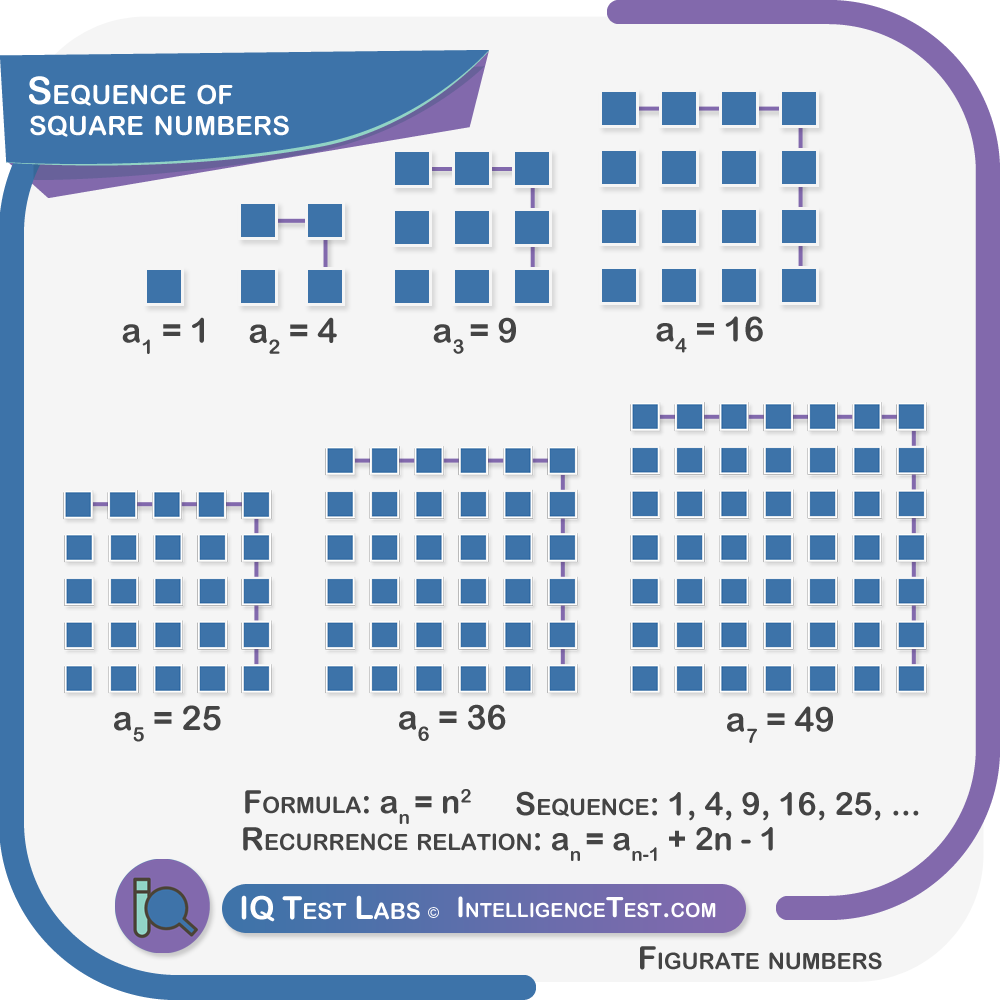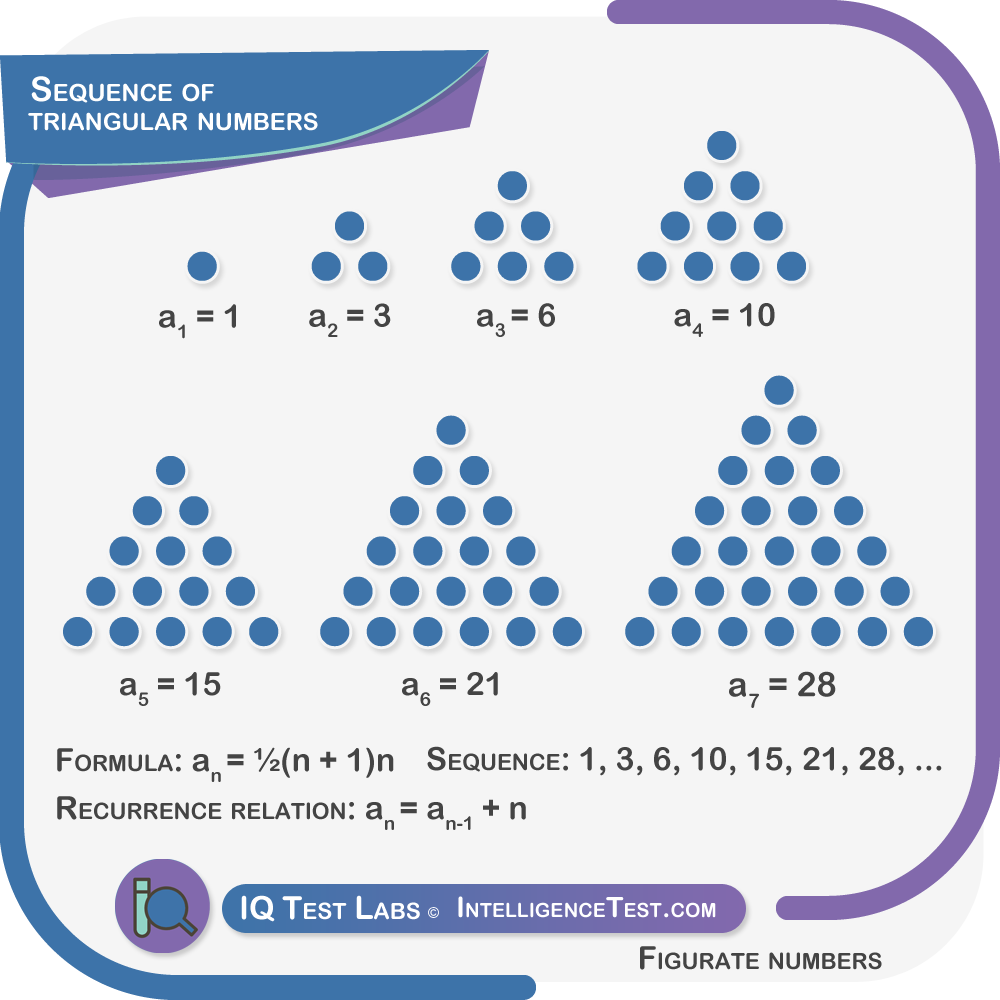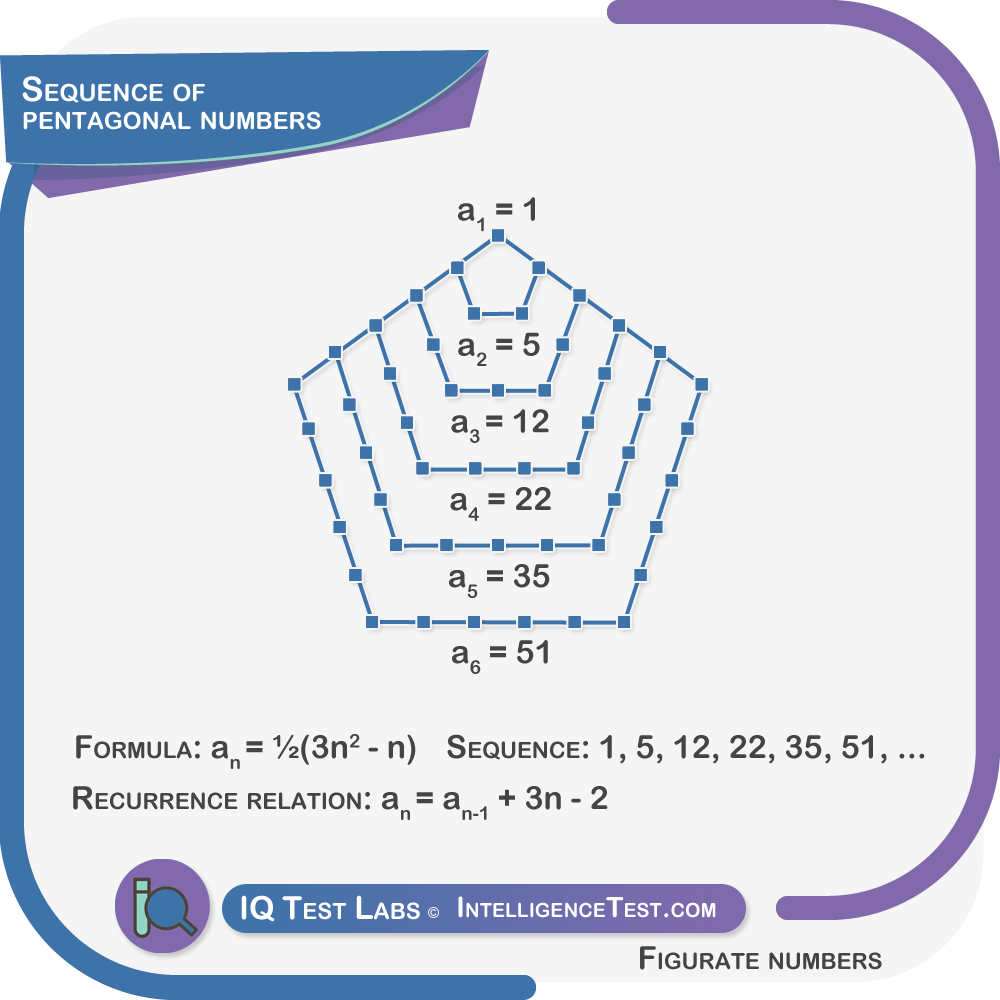Sequence types
Arithmetic progression
- The same number is added or subtracted to each preceeding term.
- The difference, 'd', between consecutive terms may be positive or negative, and is always constant.
- We can check for an arithmetic progression by using addition of subtraction to find a common difference.
Common difference: Successive term – Preceding term
Example 1
Common difference is positive:
{5, 10, 15, 20, 25, 30, 35, 40, 45, 50, ...}
d = 5
Example 2
Common difference is negative:
{25, 23, 21, 19, 17, 15, ...}
d = -2
The formula for finding the nth term, without making reference to, and listing the previous terms is:
an = a1 + (n-1)d
where 'a1' is the first term and 'd', is the common difference.
Recurrence relation: an = an-1 + d
Attempt more addition/subtraction questions.
Geometric progression
In a geometric progression each term is multiplied by a common ratio 'r'.
The common ratio can be calculated by dividing any two consecutive terms.
Check for a geometric relationship by multiplying successive terms to see if the ratio is constant.
Common ratio: Successive term/Preceding term
Example 1
Increasing geometric sequence.
{2, 4, 8, 16, 32, 64, 128, 256, 512, ...}
r = 2
Example 2
Decreasing geometric sequence.
{2187, 729, 243, 81, 27, 9, 3, ...)
r = 1/3
Example 3
The common ratio may be less than one. For example if it's a half, the sequence will look like this:
{10, 5, 2.5, 1.25, 0.625, 0.3125, ...}
r = 0.5
Example 4
The common ratio may be negative. In this case, the sequence will alternate between positive and negative:
{1, -4, 16, -64, 0.625, -256, ...}
r = -4
Example 5
In music the note A can be played in the following frequencies:
{110Hz, 220Hz, 440Hz, 880Hz, ...}
r = 2
Each frequency is multiplied by the same number each time.
Each frequency is a pitch, and the difference between pitches is an octave.
General term (nth term)
an = a1r(n-1)
where a1 is the first term and r is the common ratio.
Recurrence relation: an = (an-1)r
Attempt more multiplication/division questions.
Patterned
The terms in the sequence follow a repeating pattern. The numbers are usually increasing, decreasing, constant or alternating.
Example 1
{1, 0, 1, 1, 0, 1, ?, 1, 0, 1, 1, 1, 1, 0, 1, 1, 1, 1, ?, 0}
Answer:1 and 1.
Explanation: There is an increasing order of 'ones' between the zeros.
Example 2
{1, 33, 666, ?, 1212121212, 151515151515, ?, 2121212121212121}
Answer: 9999,18181818181818
Explanation: There are one 1s, two 3s, three 6s, four 9s etc
Attempt more patterns questions.
Sequence of square numbers

- Type of figurate number.
- Perfect squares are the squares of whole numbers.
- Square numbers are always positive.
Example:
{1, 4, 9, 16, 25, 36, 49, 64, 81, ...}
This sequence consists of repeatedly squaring numbers {1, 2, 3, 4, ...}
Formula: an = n2
Recurrence relation: an = an-1 + 2n-1
Attempt figurate number questions.
Sequence of triangular numbers

- Type of figurate number.
- The terms in the sequence represent the number of dots needed to form successive equilateral triangles.
- A new term is added to the sequence after each new triangle row.
In the triangular number sequence, each term represents a new row of dots.
1
1+2=3
1+2=3=6
1+2+3+4=10
1+2+3+4+5=15
1+2+3+4+5+6=21
1+2+3+4+5+6+7=28
Formula: an = ½(n + 1)n
Recurrence relation: an = an-1 + n
Attempt figurate number questions.
Cube series
A cube is obtained by multiplying a number by itself three times.
Formula: an= n3
Example
{1, 8, 27, 64, 125, 216, 343, 512, 729, ...}
1 = (1×1×1), 8 = (2×2×2) 27 = (3×3×3) 64 = (4×4×4) ...
What is the next number in the sequence?
Since it's the 10th number, the answer is 1,000.
1010, or 10*10*10= 1,000.
Attempt more figurate number questions.
Pentagonal number sequence

- Type of figurate number.
- The first pentagonal numbers are 1,5,12,22,35,51,70,92, ...
- This sequence consists of the patterns of dots that outline regular pentagons.
- The pentagons share a common vertex.
- Pentagonal numbers are the number of distinct dots that outline each shape.
Formula: an = ½(3n2 - n)
Recurrence relation: an = an-1 + 3n - 2
Attempt figurate number questions.
Hexagonal number sequence

- Type of figurate number.
- The first hexagonal numbers are 1,6,15,28,45,66,91,120 ...
- This sequence consists of the patterns of dots that outline regular hexagons.
- The hexagons share a common vertex.
- Hexagonal numbers are the number of distinct dots that outline each shape.
Formula: an = n(2n − 1)
Recurrence relation: an = an-1 + 4n - 3
Example
What is the sixth hexagonal number?
Replacing n with 6
a6 = 6(2 × 6 − 1) = 6(12 − 1) = 6 × 11 = 66
Attempt more figurate number questions.
Positions of terms
The position of the terms in a sequence may facilitate formulating a rule.
For example, this sequence may not, at first glance, be identified as a series of cubes.
{1,8,27,64,125, ?}
After an initial review we notice
- no addition/subtraction pattern
- no multiplication/division pattern.
- no pattern in the term differences (+7,+19,+37,+61)
The terms' positions reveal more information.
The cube series becomes more easily apparent after associating terms with their sequence positions.
{1, 8, 27, 64, ...}
| | | | |
1 2 3 4 5
1^3=1, 2^3=8, 3^3=27, 4^3=64, 5^3=125
Cyclic sequences
Some sequences demonstrate cyclic patterns; they reach certain values and then revert to their initial value.
An appropriate illustration is a time value sequence. Time increments coincide with a return to the initial time.
Example 1
Common difference is positive:
{16:45, 16:30, 16:15, 16:00, 15:45, 15:30, 15:15, ?}
Answer: 15:00
Explanation: Subtract 15 minutes from the preceeding term.
Example 2
{2123, 1232, 2321, 3212, 2123, 1232, 2321, 3212, ?, ?, ?, ?}
Answer: 2123,1232,2321,3212
Explanation: A four number cycle where the first digit is moved back. The terms repeat every four cycles.
Attempt more cyclic pattern questions.
Fibonacci series
By definition, the first two numbers are 0, and 1 (a0 = 0, a1 = 1)
All terms are obtained by adding two previous terms.
Terms in a Fibonacci series can be obtained with the formula:
an = an-1 + an-2
a6 = a6-1 + a6-2 = a5 + a4 = 5 + 3 = 8
{0, 1, 1, 2, 3, 5, 8, 13, 21, 34, 55, 89, 144, 233, 377, 610, ...}
Twin sequences
A combination of two series into a single series. It is therefore necessary to analyze each sequence separately.
Example
{2, 10, 4, 20, 6, 40, 8, 80, 10, 160, 12, 320, 14, ...}
The first series is an arithmetic progression with a common difference of two:
{2, 4, 6, 8, 10, 12, 14, ...}
The second series is an geometric progression with a common ratio of two:
{10, 20, 40, 80, 160, 320, ...}
Attempt more twin sequences questions.
Multiple operations
Multiple operations are applied to terms in a sequence, or separate operations are applied to separate terms.
Example 1
{4, 14, 44, 134, 404, 1214, ?, 10,934, ...}
Answer: 3644
Explanation: Multiply each term by three and add two.
Example 2
{5,10,8,13,?,16,14, 19, 17, 22, ?}
Answer: 11 and 20
Explanation: Add five to the first term and subtract two from the next term.
Attempt more multiple operations questions.
Odd numbers
An infinite sequence of odd numbers.
{1, 3, 5, 7, 9, 11, 13, 51, 17, 19, 21, ...}
Even numbers
An infinite sequence of even numbers.
{2, 4, 6, 8, 10, 12, 14, 16, 18, 20, ...}
Prime numbers
A number that is divisible only by one and itself.
{2, 3, 5, 7, 11, 13, 17, 19, 23, 29, 31, ...}
Composite numbers
Composite numbers are whole numbers that have two or more factors.
Whole numbers that are not prime numbers are composite numbers.
{4, 6, 8, 9, 10, 12, 14, 15, 16, ...}
Digits
- Distinct patterns in the digits of terms.
- In a two-digit number for example, the first digit might increase, while the second digit remains constant.
- Digits could follow a cycle or add up to a specific number.
Example 1
{100, 219, 328, 437, 546, 655, 764, ?}
Answer:873
Explanation: The first two digits increase by one, and the third digit decreases by one.
Example 2
{12, 34, 56, 78, 10, 32, 54, 76, 18, 30, ?, ?}
Answer: 52,74
Explanation: The first digits alternate between 1,3,5,7, and the second digits alternate between 2,4,6,8,0.
Attempt more digits sequence questions.
Multiples of numbers
Multiples of a number are those that will divide into the number exactly.
Example:
Multiples of six
{6, 12, 18, 24, 30, 36, ...}
Term differences
Patterns that occur in the differences between consecutive terms.
Multiples
{2, 6, 14, 30, 62, ...}
The differences between the terms are multiples of four:
4, 8, 16, 32.
Perfect cubes
{6, 14, 41, 105, ...}
The differences between the terms are all cubes.
23, 33, 43.
Arithmetic progression
{2, 3, 6, 11, 18, ...}
The differences between the terms have a common difference
1, 3, 5, 7
Geometric progression
{2, 3, 6, 15, 42, ...}
The differences between the terms have a common ratio.
1, 3, 9, 27
Attempt more term-difference questions.
Term ratios
Patterns that occur in the ratios between consecutive terms.
Constant ratio
{2, 8, 32, 128, 256, ...}
The ratio between each term is always four.
4, 4, 4, 4
The next term is 4 x 256 = 512
Prime numbers
{11550, 1050, 150, 30, 10, ...}
The ratio between each term is a decreasing prime.
11, 7, 5, 3
The next term is 10÷2 = 5
Arithmetic progression
{1, 4, 24, 192, 1920, ...}
The ratio between each term is in an arithmetic progression.
4, 6, 8, 10,
The next term is 12 x 1920 = 23040
Perfect square
{1, 4, 36, 576, ...}
The ratio between each term is a perfect square
4(22) 9(32) 16(42)
The next term is 25 x 576 = 14400
Multiples
{1, 3, 18, 162, ...}
The ratio between each term is multiples of 3
3, 6, 9
The next term is 12 x 162 = 1944
Perfect cube
{1, 8, 216, 10,368, ...}
The ratio between each term is a perfect cube
8(23) 27(33) 64(43)
The next term is 125 x 10368 = 1.296M
Geometric progression
{1 1 3 27 729, ...}
The ratio between each term is in geometric progression.
1, 3, 9, 27
The next term is 81 x 729 = 59049
Exponents
An exponent refers to the times a number is multiplied by itself.
In number sequences, numbers are generally raised to the power of two (a perfect square) or to the power of three (a perfect cube).
Example 1
{1, 3, 9, 27, 81, ?}
Answer:35=243
Explanation: Three to the power of zero through five.
30=1, 31=3, 32=9, 33=27, 34=81, 35=243
Example 2
{1, ?, 625, 15625, 380625}
Answer: 5^2=25
Explanation: Five to the power of all even numbers from zero to eight.
50=1, 52=25, 54=625, 56=15,625, 58=380,625
Attempt more exponents questions.
Factorials
Factorials involve multiplying an integer with all the integers below it. For example factorial three, or 3! is 3x2x1 = 6.
Addition, division, and squaring are prominient for factorials that feature in number sequences.
Example
{1, 2, 3, 6, 24, ?, 720, 5040}
Answer: five factorial or, 120.
5! = 5 x 4 x 3 x 2 x 1 = 120.
Explanation: Series of factorials, zero through seven. Remember that 0! = 1.
Creative solutions
A sequence can be made up of any list of items, and this is what makes some sequences more complex than they actually are.
When a sequence is erratic, it's usually a simple rule that has to be discovered via trial and error. Keep an open mind and try alternative patterns until something makes sense.
Example 1
This sequence is all even numbers without a one in them.
{2, 4, 6, 8, 20, 22, ...}
Example 2
This sequence is square odd numbers that contain the number nine.
{9, 49, 169, 289, ...}
Example 3
Numbers may be in alphabetical order
{8, 5, 4, 9, 1, 7, 6, 10 ...}
Example 4
Successive digits of ℼ
{3, 1, 4, 1, 5, 9, 2, 6 ...}
Example 5
For each third term, multiply the two preceeding terms.
9*5 = 45, 8*6 - 48, ...
{9, 5, 45, 8, 6, 48, 2, 6, 12, ...}
The Lazy Caterer’s Sequence
The lazy caterer’s sequence describes the maximum number of possible pieces that a disk can be divided into, with a given number of straight cuts.
The maximum circle segments that can be made with a given number of straight cuts.

Formula: an = ½(n2 + n + 2)
Recurrence relation: an = an-1 + n
{1, 2, 4, 7, 11, 16, 22, 29, 37, ...}
Look and say sequence
This sequence results by reading and saying the digits of a sequence.
Example:
{1, 11, 21, 1211, 111221, 312211, 13112221, 1113213211, ...}
It's as if there were an inventory check of numbers.
The reader would say "there is one, 1"
This makes the next term '1,1'.
The next term would be read out loud as, "two 1s" i.e '21'.
The term after that would be "one 2", i.e '12', followed by "one 1", i.e, '11', resulting in '1211'.